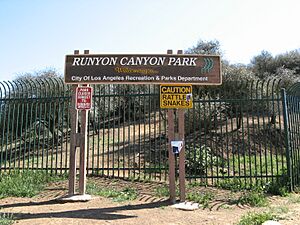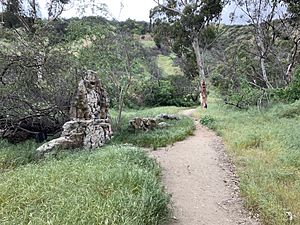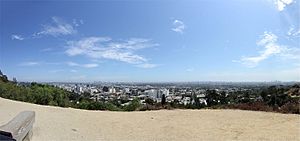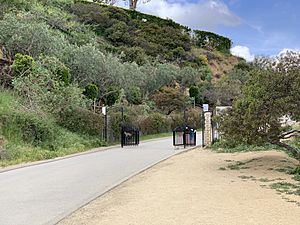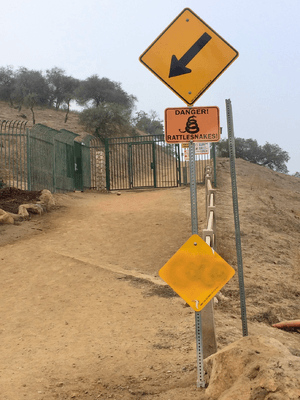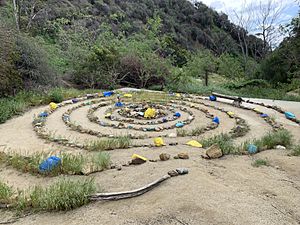Runyon Canyon Park facts for kids
Quick facts for kids Runyon Canyon Park |
|
|---|---|
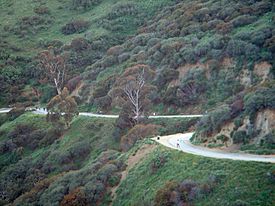
Paved path between Vista Street & Mulholland Trailhead
|
|
| Lua error in Module:Location_map at line 420: attempt to index field 'wikibase' (a nil value). | |
| Type | Urban park |
| Location | Hollywood, Los Angeles, California |
| Area | 160 acres (65 ha) |
| Created | 1984 |
| Operated by | Los Angeles Department of Recreation and Parks |
| Status | Open all year |
Runyon Canyon Park is a large, beautiful park in Los Angeles, California. It covers about 160 acres (that's like 120 football fields!) and is located at the eastern end of the Santa Monica Mountains. The city of Los Angeles takes care of this park.
You can enter the park from the south in Hollywood at Fuller Avenue. There's also a northern entrance off Mulholland Drive. A main path called Runyon Canyon Road goes through the middle of the park. It's a fire road, so cars aren't allowed, but it's great for walking! Many smaller trails wind through the park too.
The highest spot in the park is called Indian Rock, which is 1,320 feet high. Because the park is close to Hollywood, you might even spot a celebrity while you're hiking! It's also a very dog-friendly park, with 90 acres where dogs can run around off-leash. Runyon Canyon Park is part of the larger Santa Monica Mountains National Recreation Area. After some fires in January 2025, the park was closed for a short time. It started opening again in late February, but as of August 2025, a part of the west trail is still closed.
Contents
Park History
Runyon Canyon Park became a city park in 1984. Before that, it was owned by different people. Long ago, local Gabrielino/Tongva Indians used the canyon as a seasonal camp. They hunted in the area they called the Nopalera.
In 1867, a man named "Greek George" Caralambo received 160 acres of this land. He was given it for his service in the US Army Camel Corps. Later, in 1874, a famous bandit was caught hiding at his home.
Alfredo Solano, an important engineer, bought the canyon in 1877. His wife later sold most of the land to Carman Runyon in 1919. Mr. Runyon and his new wife loved to ride horses and hunt, so they bought the canyon for these activities. They even built a small house near the Fuller Avenue entrance. The canyon, a road, and a drive are all named after Carman Runyon.
Famous Owners and Their Homes
In 1930, John McCormack, a world-famous Irish singer, bought the estate. He loved the area after filming a movie there in 1929. He built a grand house called "San Patrizio," named after Saint Patrick. He and his wife lived there until 1938. You can still see parts of old gardens and buildings below the Vista gates.
When McCormack was away on tour, famous actors like Janet Gaynor and Charles Boyer sometimes rented his mansion. The McCormacks were friends with many Hollywood stars.
Later, in 1942, Huntington Hartford bought the property. He was very wealthy and loved art. He called his estate "The Pines." He hired famous architects, Frank Lloyd Wright and his son Lloyd Wright, to design new buildings. They planned a pool pavilion on a hill called Inspiration Point, which faced Hollywood.
In 1964, Hartford wanted to give the property to the city as a gift, but the mayor said no. Lloyd Wright later said that local businesses didn't want the park, and city officials refused permits. Hartford was upset and sold the property cheaply to Jules Berman.
Jules Berman, who made money selling a coffee liqueur called Kahlúa, wanted to build 157 luxury homes. He tore down the mansion and other buildings to avoid paying taxes on them. However, a park activist named Daniel deJonghe helped stop the building project in 1978. The pool-house designed by Lloyd Wright stayed until 1972, when a fire destroyed it. Only its stone foundations remain.
Modern Changes to the Park
Between 1994 and 1999, two subway tunnels for the Metro Red Line were built deep underground beneath the park. These tunnels run from the southeast to the northwest parts of the park.
In 2007, a group called The Trust for Public Land bought 14.9 acres of private land in Runyon Canyon. This cost $8.75 million and helped make sure the park would stay open to the public. It also protected the beautiful views from being blocked by new buildings.
Exploring the Trails
There are five ways to get into Runyon Canyon Park. Two entrances are at the bottom of the park on Fuller and Vista Streets. Another is at the top of Runyon Canyon Road on Mulholland Drive, which has a parking area. There's also an entrance at Solar Drive and a path from Wattles Garden. For the entrances without parking lots, you'll need to find street parking.
Popular Hiking Routes
From the Fuller Gate, you can choose from three main paths:
- Runyon Canyon Road (easy): This is a gentle climb on a paved road. It goes towards the back of the canyon.
- Star Trail (medium): This path has some steep parts and famous railroad-tie steps.
- Hero Trail (difficult): This is the westernmost trail. It starts with an 18-degree slope and goes along a ridge, offering amazing views.
If you do a loop using Runyon Canyon Road and Star Trail, it usually takes about 30–45 minutes. The Hero's Trail is more challenging and can take 45–60 minutes. If you add a trip to Indian Rock, it will take another 10–20 minutes.
From the Mulholland Drive entrance, you can take short hikes up Indian Rock for 360-degree views. You can see the valley to the north from here. Another option is to follow the fire road around the rock and choose different paths.
There's also a trail through the bottom of the canyon. It passes by old ruins and a large foundation slab. This slab is often decorated with mosaic patterns or messages made from rocks. This path follows what used to be a river bed. The last part of this route can be a bit tricky with cactus and overgrown bushes.
The upper canyon trails are home to many animals. You might see birds, owls, hawks, snakes, lizards, deer, and coyotes. Coyotes are often seen early in the morning or at dusk. The park also has hundreds of plant types, like black sage, elderberry, and laurel sumac.
Rock Mandala
In a quiet valley off the main trails, you'll find the Rock Mandala. This is a public artwork created in 2008 by director Robert Wilson. It's a sculpture made of rocks, some weighing up to 300 pounds! People often use it as a place to meditate or exercise, and it's regularly cared for.
Park Management
Managing Runyon Canyon Park has sometimes been a topic of discussion since it opened in 1987. There were plans for a small parking lot and a special dog park. However, the park opened without the parking lot, and the off-leash dog area became much larger. This made the park very popular.
Neighbors started complaining about parking, traffic, and safety issues, especially near the Mulholland and Vista Street entrances. This led to parking rules on nearby streets. In 2003, a volunteer board was formed to help solve these problems. They suggested closing one gate and having dog owners pay a fee for park upkeep. However, these ideas were not put into action. In 2009, plans for a parking lot were put on hold.
Park Mentions
Runyon Canyon Park has appeared in popular culture. A bench overlooking Los Angeles in the 1992 Seinfeld episode "The Trip, Part 2" is located in the park.


